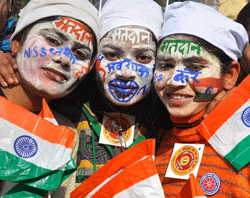
The historical Rajpath avenue has over time become synonymous with the Republic Day anniversary ceremony, but the boulevard that runs from Rashtrapati Bhavan on Raisina Hill through Vijay Chowk and India Gate was not the venue of first celebrations marking the birth of the Republic.
Exactly 63 years ago, after having thrown off the British colonial yoke, a free India assumed the mantle of a "Sovereign Democratic Republic" on January 26, and an amphitheatre named after an erstwhile Viceroy, became the venue for the festivities after the country got its first President.
The chain of events marking the birth of a landmark in the annals of India's Independence movement make for a fascinating read. "At the most solemn ceremony, held in the brilliantly lit and high domes of Durbar Hall at Government House, India was declared a Sovereign Democratic Republic exactly at eighteen minutes past ten on the morning of Thursday, January 26, 1950. Six minutes later, Dr Rajendra Prasad was sworn in as President," reported "Fauji Akhbar" (now 'Sainik Samachar') in its article titled 'Birth of a Republic' on February 4, the same year.
"The birth of Indian Republic and the installation of its first President were announced by a salute of 31 guns shortly after 10:30 am," reports the publication. In an impressive swearing-in ceremony, the retiring Governor-General, C Rajagopalachari, read out the proclamation of the Republic of "India, that is, Bharat".
"... And whereas it has been declared by the said Constitution that India, that is, Bharat, shall be a Union of States comprising within the Union the territories which were hitherto the Governor's provinces, the Indian states and the Chief Commissioners' provinces," the military journal quoted the last Governor-General's speech.
The President then took the oath and made a brief speech, first in Hindi and then in English. "Today for the first time in our long and chequered history we find the whole of this vast land from Kashmir in the north to Cape Comorin in the South, from Kathiawad and Kutch in the west Coconada and Kamrup in the east, brought together under the jurisdiction of one Constitution and one Union which takes over the responsibility for the welfare of more than 320 million men and women that inhabit it," President Prasad said in his historic speech.
Though India had been used to pomp and pageantry having witnessed three imperial durbars before Independence, but the ceremonial splendour of that occasion was very special as the President's procession wound through the Delhi streets in a symbolic gesture of coming-of-age of a nation.
The over 100 year-old journal had said, "The President drove out of the Government House (now Rastrapati Bhawan) in state exactly at 2:30 pm in a 35-year-old coach specially renovated for the occasion bearing the new emblem of Asoka's capital and drawn by six sturdy Australian horses, at a slow trot, escorted by the President's bodyguard."
And, as the procession made its way through the Irwin Amphitheatre (now National Stadium) chants of "jai" echoed through the streets with cheers of people perched on trees and building roofs and every possible vantage point.
The people's President as he would come to be known as later in his office, responded to the joyous greetings of the gathered masses with warmth and folded hands. "The drive ended exactly at 3:45 pm at the Irwin Amphitheatre where 3,000 officers and men of the three Armed Services of India and the Police with massed bands had taken positions for the Ceremonial Parade," reported the article.
In what would serve as the precursor to the grand festivities in later decades on the Rajpath, the Amphitheatre housing 15,000 people witnessed one of the most magnificent military parades in India's recent history.
"The recollection of the historic coverage of the first R-Day fills our heart with pride and amazement. And, more than 100 years later we still find it challenging to maintain the highest standards of reportage set by our predecessors," V K Joshi, current editor, "Sainik Samachar" told PTI.
Seven massed bands, representing the three armed forces and the police regaled the spectators while units of the Forces, and native contingents and regiments added colour and precision to the solemn occasion.
"But, perhaps the greatest draw of the day was the feu de joie ('running fire of guns') accompanied by the National Anthem as guns thundered in salute to the nation's first President," said Joshi, recalling the 1950 issue.
Iconic monochrome images of Homai Vyarawalla, India's celebrated first woman photojournalist, of January 26, 1950 has also etched that day in history forever. The marching troops at the Amphitheatre against the backdrop of the Old Fort (Purana Qila) or Rajendra Prasad taking a ceremonial ride at the Great Place (now Vijay Chowk) without any security cover, stand today as signatures of that momentous day in Indian history before the venue shifted to the Rajpath the next year onwards.
Incidentally, Lord Irwin was the then Viceroy of India when New Delhi was formally inaugurated in February 1931, as the new capital of the British India in a grand ceremony.
But, it wasn't just the Capital celebrating the red-letter day. "At home countless people rejoiced and celebrated the historic occasion and the proclamation of the Indian Republic was read out in all the states of the Indian Union. Abroad too, Indians marked the occasion with fitting celebrations," the journal recounted.
Messages of goodwill were received from the heads of states of almost all the countries of the world as the "Dominion of India turned a historic corner".